This article is part of a series on smart irrigation controllers. The rest of the series can be found at https://edis.ifas.ufl.edu/entity/topic/SERIES_Smart_Irrigation_Controllers.
Introduction
Florida has sandy soils in many areas of the state resulting in poor water retention to meet plant water needs. During dry periods, there may not be enough rainfall to maintain acceptable landscape quality. Also, rainy periods have infrequent, high intensity rain events causing only a small portion of water to infiltrate and remain in the root zone while the rest is lost to deep percolation and runoff. Drought conditions can occur in as little as a few days without rain. Previous research has shown that homeowners using in-ground, automatic irrigation systems, typical in Florida, apply 47% more water for landscape irrigation than homeowners without automatic irrigation systems. This over-irrigation is largely due to a "set it and forget it" mentality despite seasonal fluctuations in plant water needs (Mayer et al. 1999).
"Smart Irrigation Control" technologies for irrigation have been developed to apply irrigation to the landscape based on plant water needs while conserving increasingly limited water resources. One type of technology is an evapotranspiration-based irrigation controller, or ET controller. General information on ET controllers and other smart irrigation technologies can be found in What Makes an Irrigation Controller Smart https://edis.ifas.ufl.edu/publication/ae442.
This publication will present the operational techniques of several commercially available ET controllers that are being studied at the University of Florida.
Irrigation Scheduling
The water requirement of plants can be determined from a balance of water inputs and outputs to the root zone and is called a soil water balance (Figure 1). Rainfall and irrigation enter the root zone as inputs. A shallow water table could also provide water for plant needs through capillary action. Water exits the soil and plant system from runoff, deep percolation, evaporation, and transpiration; these are considered outputs from the soil water balance. Evaporation is the loss of water to the atmosphere from the soil surface and transpiration is the loss of water from respiration of the plants (Allen et al. 1998). When calculating the soil water balance, evaporation and transpiration are combined into one term, evapotranspiration (ET).
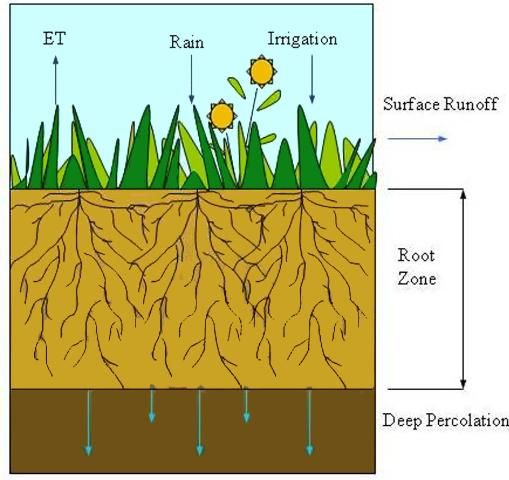
Credit: Mary L. Shedd, UF/IFAS
Equation 1 is used for calculating the change in soil water in the root zone (Irrigation Association [IA] 2005). Generally, on sandy soils common in Florida, unless there is excessive compaction or other properties that decrease infiltration of water, it can be assumed that there is negligible surface runoff. Also, irrigation is scheduled so that, ideally, there are negligible losses. Deep percolation is minimized by irrigation events that do not exceed the soil water holding capacity, while surface runoff is minimized by using irrigation events just long enough to infiltrate the soil but not runoff (i.e. cycle/soak). The change in storage is typically very small in Florida's sandy soils between necessary irrigation events. These assumptions reduce Equation 1 to an equation used to calculate the irrigation depth required:
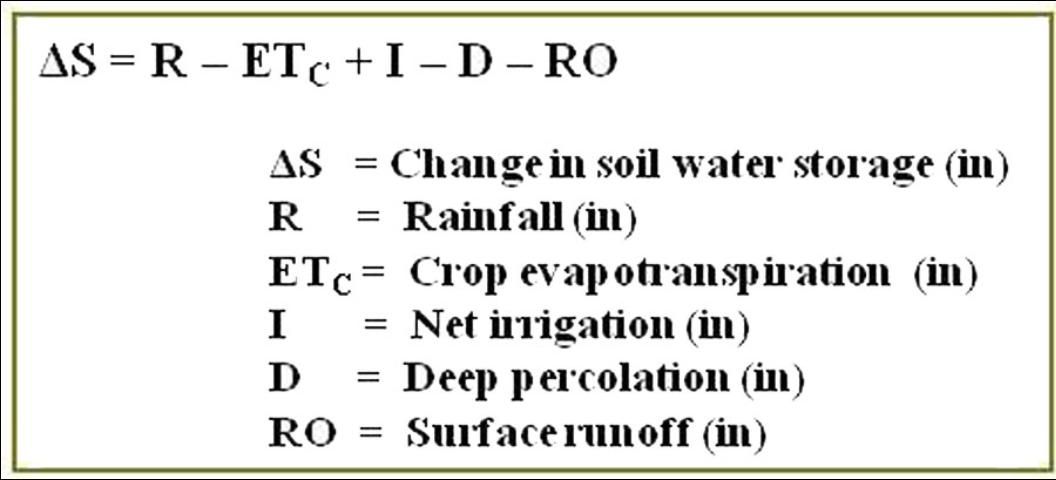
Equation 2 is a simplified version of Equation 1 used to calculate net irrigation depth required by assuming negligible drainage, runoff, and change in storage.

Effective rainfall refers to the amount of rainfall that is stored in the root zone (IA 2005). The ability of the soil to retain water is the soil water holding capacity (IA 2005). Rainfall that is greater than the soil water holding capacity of the root zone is assumed to drain or run off and is no longer useful to the plant. So how much water can your soil hold?
Calculating Soil Water Content
The root zone of a plant is the depth of soil from the surface that can be used by the plants to obtain water for physiological processes. The amount of water that can be stored in the root zone is a function of the type of soil texture. The permanent wilting point (PWP) of the soil is defined as the depth or percentage of water in the root zone causing plants to wilt permanently without recovery (IA 2005; Figure 2). Alternately, field capacity (FC) is defined as the water level when the rate of downward movement in the root zone due to gravity has substantially decreased after saturation (IA 2005). Theoretically, irrigation should be applied before reaching PWP and filled to FC. Both PWP and FC vary with soil texture where the more sandy a soil the less water that can be stored and the more clayey a soil, the more water that can be stored.
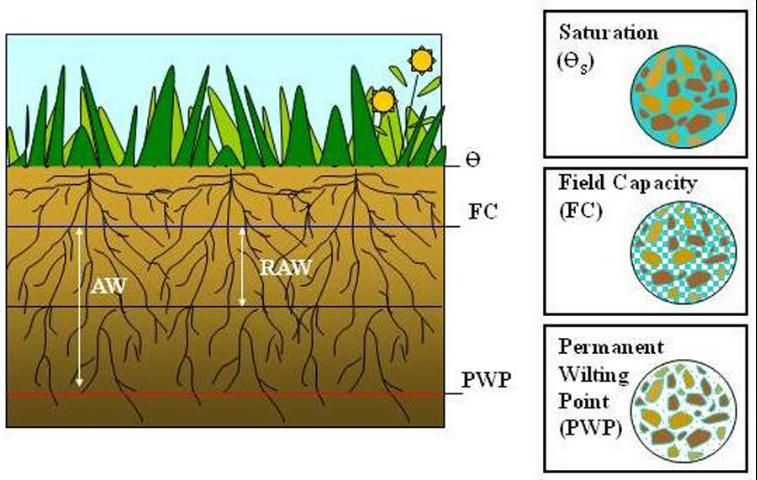
Credit: Mary L. Shedd, UF/IFAS
Based on the above definitions, the amount of water available for use by the plant falls between FC and PWP and is termed available water, AW (IA 2005; Equation 3). To prevent plant stress, AW should not be allowed to reach the PWP before irrigation is scheduled; irrigation should be applied when the available water level drops by a percentage known as the maximum allowable depletion, MAD (IA 2005). 50% is often a rule of thumb in absence of more specific information. The amount of water allowed to be used before irrigation is required is called readily available water, RAW (IA 2005; Equation 4). As time passes, water is lost from the root zone through ETC. Daily values of ETC are added cumulatively, taking into account effective rainfall, until it equals or is greater than RAW. Once the RAW is depleted, irrigation should occur to fill the soil water store to field capacity.
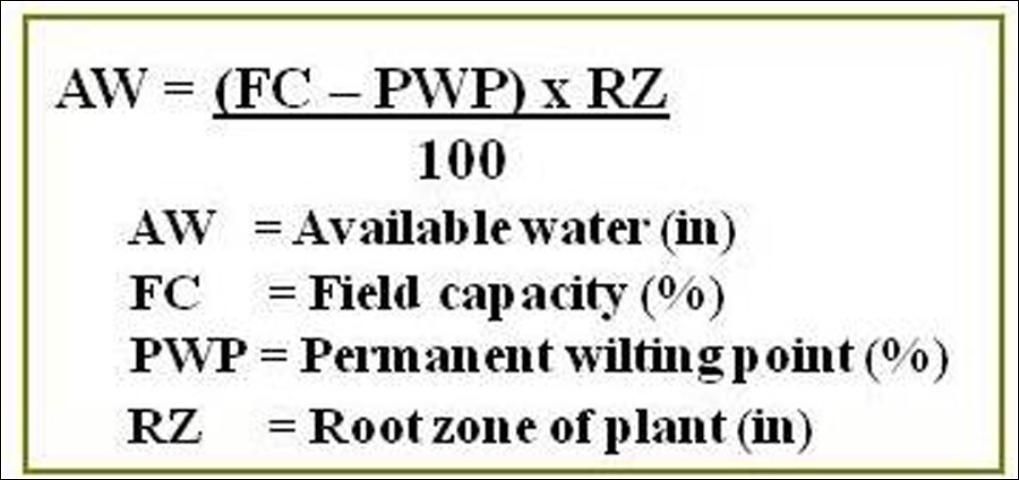

Calculating Evapotranspiration
Reference evapotranspiration (ETO) is defined as ET from a reference surface using grass at a 0.12 m height that is adequately watered, actively growing, completely covering the soil, and with a fixed surface resistance (Allen et al. 2005). The ASCE standardized reference evapotranspiration equation is considered the standard for ET calculations and is commonly used to calculate ETO as seen in Equation 5. This equation is used for daily ETO calculations and is based on wind speed, temperature, relative humidity, and solar radiation (Figure 3). More information on this method and calculation details can be found at https://ascelibrary.org/doi/book/10.1061/9780784408056.

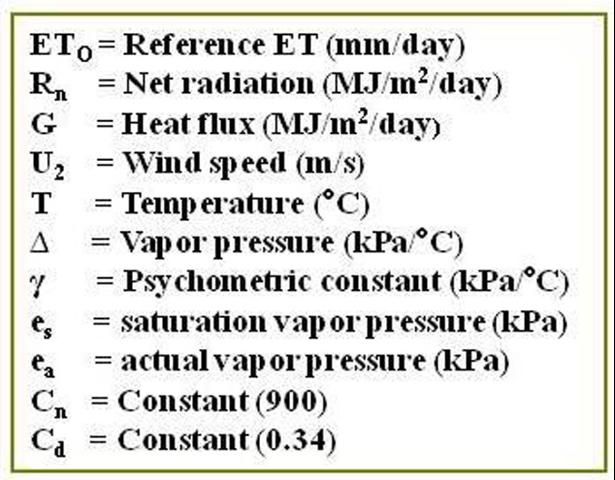
Plant ET (ETC) is defined as ET applicable to a specific plant other than the reference crop. ETC can be calculated for a specific plant material by applying a crop coefficient (KC), using the following equation:

Crop coefficients can be found in a number of references depending on the specific crop, horticultural practices, and geographical location.
ET Controllers
ET controllers are irrigation scheduling devices that use the principles of the soil water balance to schedule irrigation amounts and timing. The basic operation of ET controllers is described in What Makes an Irrigation Controller Smart https://edis.ifas.ufl.edu/publication/ae442.
Signal-Based Controllers
These controllers utilize wired (phone) or wireless (cellular or paging) communication to receive ETO data. Weather information is gathered from publicly available or dedicated weather stations near the controller location. Some manufacturers gather the climatic information from the weather stations, calculate a daily value for ETO, and then broadcast the value directly to the controller each day. Other manufacturers may broadcast weather data from weather stations and the controller then calculates ETO. ETC is calculated from the ETO and crop coefficients depending on the plant type selected. The advantage of these controllers is that they adjust in response to actual weather conditions. However, the disadvantage to this approach is that the weather conditions at the weather station data source may not be representative of conditions at the controller location. In particular, Florida site-specific rainfall is very important since rainfall can satisfy much of the plant water requirement. An adequate signal is also important for ensuring accurate soil water balance calculations. Some ET controllers utilize historical data until the signal to the controller is regained; others use the last broadcasted ETO value for each day the controller is not in communication. Signal-based controllers generally have the option of adding an external antenna if the built in antenna is insufficient. Newer to the market are signal-based controllers that utilize Wi-Fi to receive weather data.
Standalone Controllers
These controllers utilize sensors installed on-site to measure weather conditions and then calculate real-time ETO based on the data collected. The sensors collect readings at intervals anywhere from every second to every fifteen minutes and then daily ETO is calculated from those values. On-site sensors could include: temperature, solar radiation, or even a full weather station (Riley 2005). However, installing weather stations at every home is not practical or economically feasible; therefore, simplified ET estimation methods are typically used. For example, the Weathermatic Smartline controller uses Hargreaves equation instead of the ASCE standardized ETO equation. Hargreaves equation is temperature dependent allowing the sensor to measure only temperature (Jensen et al. 1990). The advantage of this approach is that ET is measured on-site and signal fees are not required. The disadvantage is that simplified methods are not accurate across a wide range of climate conditions (Jensen et al. 1990).
Add-on ET Controllers
Some ET controllers are add-on devices to automatic timers and are not equipped with the ability to calculate runtimes. Instead, they use the soil water balance to determine if an irrigation event will occur.
Conclusion
Detailed programming recommendations for several controllers in Florida conditions can be found in Programming Guidelines for Evapotranspiration-Based Irrigation Controllers https://edis.ifas.ufl.edu/publication/AE445.
Note that the University of Florida does not endorse any particular brand but that the information contained here is for illustrative purposes only.
References
Allen, R.G., L.S. Pereira, D. Raes, and M. Smith. 1998. Crop evapotranspiration – Guidelines for computing crop water requirements. FAO Irrigation and drainage paper 56. Available at: http://www.fao.org/docrep/X0490E/x0490e00.htm (accessed March 2019).
Allen, R.G., I.A. Walter, R. Elliot, T. Howell, D. Itenfisu, and M. Jensen (eds). 2005. The ASCE Standardized Reference Evapotranspiration Equation. American Society of Civil Engineers Environmental and Water Resource Institute (ASCE-EWRI). 59 pp.
Irrigation Association [IA]. 2005. Landscape Irrigation Scheduling and Water Management. Available at: http://www.irrigation.org/gov/pdf/IA_LISWM_MARCH_2005.pdf (accessed January 12. 2007).
Jenson, M.E., R.D. Burman, and R.G. Allen. 1990. Evapotranspiration and Irrigation Water Requirements. ASCE Manuals and Reports on Engineering Practices No. 70. American Society of Civil Engineers. New York, New York.
Mayer, P. W., W. B. DeOreo, E. M. Opitz, J. C. Kiefer, W. Y. Davis, B. Dziegielewski, and J. O. Nelson. 1999. Residential End Uses of Water. AWWA Research Foundation and American Water Works Association. Denver, Colorado.
Riley, M. 2005. The cutting edge of residential smart irrigation technology. California Landscaping. July/August pp. 19–26.